
Over the past few years the number one request is in regard to the pickup selector switch on the guitar model. After five decades the switch on
many guitar models have simply worn out, resulting in many guitarists asking me about a replacement as many toggle type switches will not fit
within the limited confines of the instruments control cavity.
Above left is my answer. A Servalite L40 EU - H# 393210 'SPDT On-Off-On' switch is the one you want. You may also see it advertized as
LR107402 SPDT (2-circuit) Toggle Switch On/Off/On 125vac-15a / 240vac-10a. Though different numbers, they are the same switch.
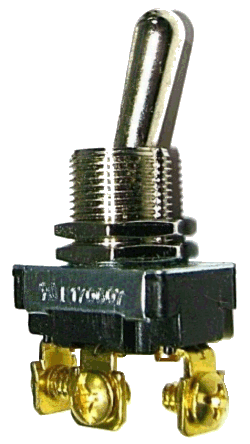
|
At left, a closeup look at the Servalite switch. Notice its shallow depth (the black portion) which is crucial - for the depth of the routed
portion of the acrylic body on the Dan Armstrong plexi is only three quarters of an inch deep. Because of this shallow depth, many players
have resorted to using one of those micro type switches. Unfortunately, they look nothing like the original switch that came from the factory.
Also, an additional, and smaller hole needs to be drilled through the scratchplate as the factory switch hole is too big for those switches.
This switch has the exact look and feel to its bat handle, and the switch even feels the same when using it. It's virtually identical to the
original Carling Technologies switch that came inside your Dan Armstrong guitar. A complete, detailed 'step by step' instruction guide with
photos will show you how to install and wire up this switch in your guitar which can be read in its entirety in the
hardware section of this site.
|
As seen above left and right, the Servalite switch has replaced the original Carling Technologies switch in one of my Dan Armstrong guitars. It
not only works the same it 'feels' the same, as though I hadn't even changed it. This is the switch for the 1969-71 model Dan Armstrong guitars.
Honestly, had I not done it myself, I would have never known it's a replacement. You can see a closeup view of this switch
here if you wish.
Unfortunately, you cannot order from this site as they only sell to dealers.
An email I received from them had the following: "If you aren't a business you can purchase any of our products at any of your local hardware
stores like Ace's, True Value, Menards, Home Depot and Lowe's. If you visit a Lowe's or Home Depot, please be sure to visit someone at the 'pro
desk' as they'll be able to assist you. If something is not in stock, any of them can order it in for you. If a store doesn't have the specific
item you are looking for, we suggest you speak with someone at the store and they can special order the item from Hillman on your behalf."
As of this writing E-Bay currently has Servalite L40 EU - H# 393210 'SPDT On-Off-On' switches for sale. But if 'push comes to shove' you can
always purchase the switch below. Though it's meant for the re-issue models it will work just fine on the older models.
Above left and right, Juan Castellano contacted me in regard to a broken pickup selector switch on a 2007 re-issue
Dan Armstrong · Ampeg guitar. While the Servalite selector switch mentioned at the top of this page would work, the switch
on the reissue models have a little different look to them. I informed him that I would have to do some research to find a suitable replacement. I then asked him for some photos of the switch underneath the scratchplate.
Notice, at right, about halfway and to the left... between the bat handle of the switch and the remainder of the switch body lies an aluminum
ring of sorts.
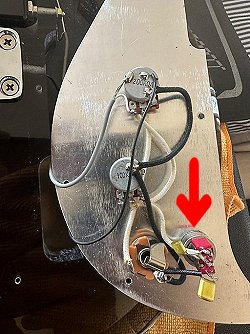
|
At left, on a different reissue model, and pointed out by arrows, this 'ring' can be seen in its entirety, still in place. I can only speculate
that this ring threads onto the switch before it is secured in place and is tightened down by an upper piece seen in the photo at upper right.
Without this ring in place, and as cab be seen in the next two photos below, lies a hole by the switch where the ring once helped secure the
switch in place.... along with its upper half, of course.
|
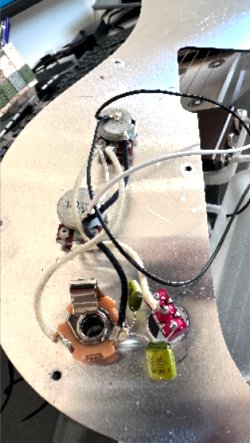
|
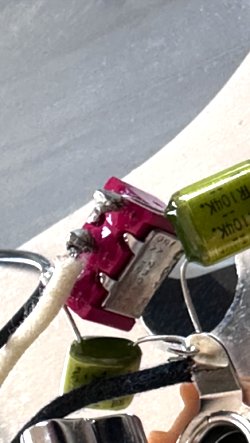
|
Juan spent no time at all getting me the needed pictures. As seen upper left, a photo of the underside of the scratchplate showing the
shielding underneath the scratchplate as well as all the components. At right, notice that two rectangular shaped lime colored capacitors have
since replaced the old capacitors seen on the original 69-71 models.
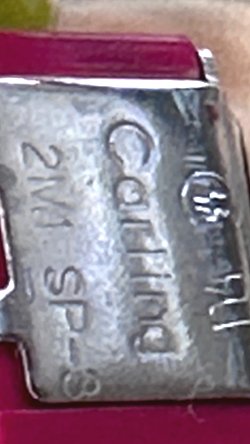
|
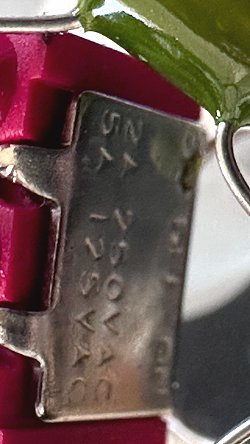
|
At left, Juan sent some great photos of the switch that ultimately helped me find a suitable replacement as the side of the switch reveals that
after 50 years Ampeg went right back to Carling Technologies for switches to use in their reissue guitars. At right, on the other side of the
switch and at the top it reads 'off - on - off' which tells us it's a single pole, double throw (SPDT) type switch. Below, it gives the power
rating that tells us the switch will handle up to 2 amps at 250 volts AC and 5 amps at 125 volts AC. Given the small voltages that an electric
guitars pickups can produce, these power rating are of no concern. So my search for a Carling Technologies switch was underway.
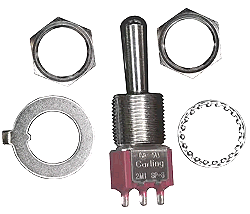
|
I did a search for the Carling Technologies web site
here
which has the exact switch that's in Juan's guitar. Although it has the Carling name on it, the switch is actually a product of Digi-Key. I
was about to inform him that he could order the switch directly from their web site when I noticed over at the right side of the web page that
it states that they only sell this particular switch in lots of one hundred.
If you're the Ampeg company, and manufacturing hundred's of instruments this is very affordable, and a great way to do business. But if your a
person in search of just a single replacement switch it's definitely not what you're looking for. So I sent another email to Juan to let him
know this, and that I was still looking around.
|
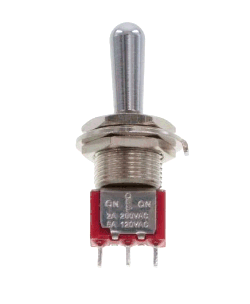
|
At left, after looking around more I ran across this Digi-Key switch that's exactly like the Carling stamped switch shown above. The good
news is - that it's sold individually and at a very reasonable price. I immediately shot off an email to Juan to let him know about this switch
and how it's identical to the Carling switch and that it's possible to order just one switch. A moment later Juan replied, letting me know that
he had already ordered one. I too, had ordered one, mostly just to study it more as I was curious to see how well it fits within the control
cavity of the Dan Armstrong guitar.
|
I didn't have a Dan Armstrong · Ampeg scratchplate handy so I grabbed a piece of cardboard that was pretty rigid and was
close to the thickness of the Dan Armstrong scratchplate. I only needed it to make a measurement of how far down the switch protrudes as the
control cavity in the Armstrong guitars are only three-quarters of an inch deep. I wasn't very concerned after seeing this brand of switch in
Juan's Dan Armstrong guitar.
With the switch snugged up to the cardboard I'm ready to measure. At right, my metal ruler shows the switch is just under three-quarters of an
inch, and will fit in the control pocket of the Dan Armstrong guitar. You can make even more space, if you want, by allowing more threads to
protrude through the top of the scratchplate. This is certainly a matter of personal taste, but I'm not a big fan of having alot of threads
sticking through the scratchplate, as it just looks tacky to me. I like the hardware to appear as original as possible.
At left and right, unlike switches of the past, looking down into this switch reveals a plastic or nylon insert, that acts somewhat like a glide
of sorts, keeping unwanted debris out while at the same time allowing a smoother, cleaner transition between switch settings. This switch will
also work on the older, original 1969-71 Dan Armstrong guitars if so desired. You can order this switch
here.
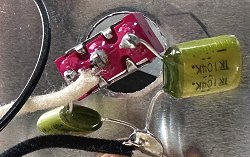
|
At left, and better seen in the enlarged views is the wiring scheme for the re-issue switch, which is pretty much the same as the original
1970-71 models. As seen here, one leg of the two green capacitors attach to the outer lugs on the switch, while the white wire from the tone
control solders to the center lug of the switch.
|
readers menu
main menu
Names and images are TMand © Dan Armstrong / Ampeg. All rights reserved.
All other names and images are TMand © of their respective owners. All rights reserved.
|
| |

